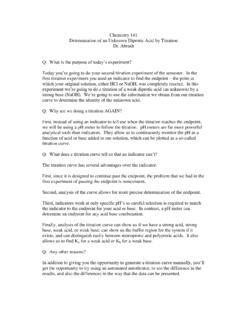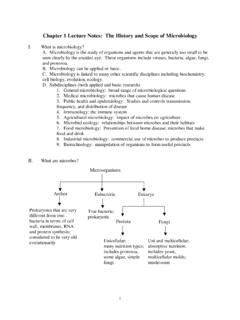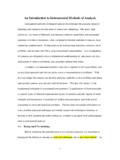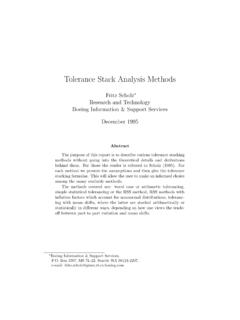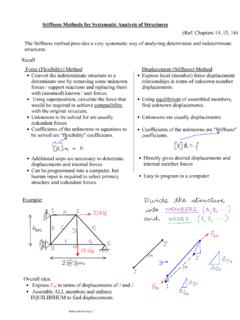Transcription of Titrimetric Analysis: Methods
1 Titrimetric analysis : MethodsTitrimetric Methods of analysis are capable of rapid and convenient analyte determinations with highaccuracy and precision. Titrimetric analysis is based on the complete reaction between the analyte anda reagent, the titrant:aA + tT t productswhere A and T represent the analyte and titrant, respectively, and a and t are the stoichiometriccoefficients. Titrations are often classified by the nature of this titration reaction: acid-base, redox,precipitation and complexation reactions are the most common reaction volumetric titrations, the amount, nA, of analyte in the sample can be calculated usingnA=atCTVT where CT is the concentration of the titrant, and VT is the volume of titrant needed to reach theendpoint.
2 Thus, quantitative determination of the analyte concentration requires the following:1. There is a stoichiometric reaction between analyte and titrant. This reaction should be fast andcomplete, and the values of a and t must be The concentration of the titrant solution, CT, must be known accurately. The titrant solution mustbe standardized either by preparing it using a primary standard or, more commonly, titrating itagainst a solution prepared with a primary The endpoint volume must be measured accurately using an appropriate chemical indicator orinstrumental method. If an instrumental method is used to follow the progress of the titrationreaction, a titration curve may be generated, which allows for the analysis of mixtures and/or thedetection of this document, we will examine some of the specifics of Titrimetric analysis : the most commontitrants and the types of analytes they react with, Methods of titrant standardization, the stability oftitrant solutions, Methods of endpoint detection, and any other details that might be , a few important examples of the application of Titrimetric analysis will be given.
3 Theseapplications will be taken from the field of water and wastewater of the material in this handout was taken from the following references: GH Jeffery, J Bassett, J Mendham, RC Denney, Vogel s Textbook of Quantitative ChemicalAnalysis, 5th edition HA Laitinen, WE Harris, Chemical analysis , 2nd edition Standard Methods for the Examination of Water and Wastewater, edited by AD Eaton, LS Clesceri,AE Greenber, 19th editionThe relevant chapters in your textbook are: Harris chapters 7, 12, 13, 16 Page 1 Titrimetry MethodsAcid-Base TitrationsAqueous Acid-Base TitrationsGeneralProton transfer reactions in aqueous solutions are quite fast.
4 Aqueous acid-base titrations are thussuitable for the analysis of any Bronsted acid or base. Practically, the pKa or pKb of the analyte shouldbe less than about 10 ( , pKa or pKb < 10) for a complete reaction between analyte and TitrantsIn order for the titration reaction to go to completion, a strong acid or a strong base is the usual choicefor a titrant in acid-base titrations. The levelling effect in aqueous solutions should be kept in mind,however: the strongest acid that can exist at a substantial concentration is the hydronium ion, H3O+,since any strong acid HA will react completely with water:HA + H2O t A + H3O+Thus, titrating with any strong acid is equivalent to titrating the analyte with hydronium , the strongest base that can exist in water is the hydroxide ion, OH.
5 For the analysis of bases, the most common aqueous titrant is HCl; sometimes H2SO4 or HClO4 arealso used. Any of these may be standardized by tris(hyddroxymethyl)aminomethane, (HOCH2)3 CNH2,which is sometimes referred to simply as tris. Sodium carbonate, Na2CO3, can also serve as a primarystandard, but it is less desirable than tris due to its lower equivalent weight. Titrations of bases aresometimes called alkalimetric the analysis of acids, NaOH is usually used; KOH or Ba(OH)2 may also be used. Any of thesemay be standardized against potassium hydrogen phthalate (KHP). The hydrogen phthalate anion isshown of acids are sometimes called acidimetric alkaline solution will absorb substantial amounts of carbon dioxide from the atmosphere,resulting in the following net reaction:CO2 + 2OH l CO32 + 2H2 OPage 2 Exposure of aqueous NaOH or KOH titrant to the atmosphere results in carbonate error.
6 Solidhydroxide salts may also contain significant amounts of carbonate impurities due to absorption ofatmospheric CO2. A NaOH titrant solution is best prepared by dilution from a concentrated(approximately 50 w/w%) solution. Sodium carbonate is insoluble in this solution. The diluted titrantsolutions are sometimes boiled to drive dissolved CO2 out of the solution and then protected fromexposure to air. The absorption process is fairly slow, occurring over a period of hours and , acidimetric titrations should be performed with a freshly prepared and standardized solutionof Acid-Base TitrationsGeneralSometimes acid-base titrations are performed using a solvent other than water.
7 There are severalreasons why nonaqueous acid-base titrations may be used instead of aqueous titrations:1. The sample is insoluble in Sample and/or titrant reacts with water in undesirable For the analysis of very weak acids or bases. As mentioned previously, an aqueous acidimetrictitration is limited to bases with pKb less than about 10. Otherwise, the reaction between titrant( , H3O+) and analyte will be incomplete. One solution to this problem for weak bases would beto use a stronger titrant an impossibility in aqueous solutions. However, using glacial acetic acidas the solvent would solve that problem, since the strongest possible acid is H2 OAc+ (a strong acidindeed).
8 Most strong acids do not completely dissociate in acetic acid. Thus, perchloric acid inacetic acid is a much stronger titrant than the same acid in water. Similar considerations apply toalkalimetric Selectivity is sometimes enhanced in nonaqueous solutions ( analysis of analytes with similardissociation constants). In aqueous solutions, a difference of 2 pK units is necessary to observedistinct endpoints. However, careful choice of solvent can sometimes allow the observation ofdistinct endpoints that cannot be measured in aqueous Titrants for Nonaqueous Acid-Base TitrationsAlkalimetry in Nonaqueous Solutions HCl in isopropanol HClO4 in glacial acetic acid these titrants may be standardized by tris, just as in aqueous titrationsAcidimetry in Nonaqueous Solutions KOH in ethanol, methanol, or isopropanol sodium methylate, NaOCH3, in methanol or chlorobenzenePage 3 nonaqueous alkalimetric titrants may usually be standardized by benzoic acid.
9 Which is soluble inmost of the solvents commonly usedInstrumental Endpoint Detection in Acid-Base TitrationsPotentiometric endpoint detection using a pH meter is the universal instrumental method used foracid-base titrations, both in aqueous and nonaqueous solvents. Special care of the pH electrode isnecessary for nonaqueous titrations in particular, the electrode must not be allowed to Applications of Acid-Base TitrationsKJeldahl analysis of Organic NitrogenThe Kjeldahl procedure is a method for the analysis of organic nitrogen in the 3 oxidation state. Thesample is digested with sulfuric acid to convert the organic nitrogen to ammonium, NH4+.
10 Thedigested sample is then basified and ammonia is then distilled into acid. The ammonia may bedistilled into excess standard HCl; the amount of HCl remaining after the distillation is determined byalkalimetric titration. Alternately, ammonia may be distilled into excess boric acid, H3BO3; thedihydrogen borate, H2BO3 , formed by reaction with ammonia is determined by acidimetric following figure shows apparatus that can be used for Kjeldahl 4 Kjeldahl analysis is often used in the analysis of surface water and wastewater. The total Kjeldahlnitrogen (TKN) content of a water sample is a measure of the total concentration of nitrogen in the 3 oxidation state in the sample: ammonia/ammonium plus organic nitrogen.





